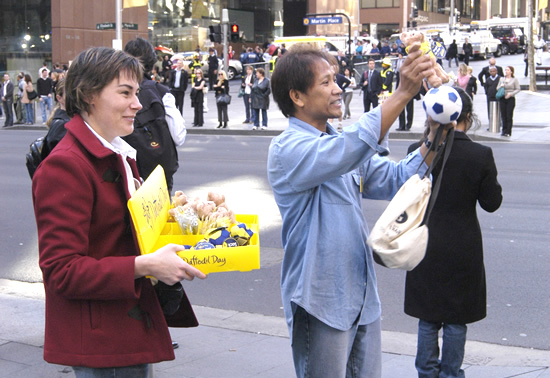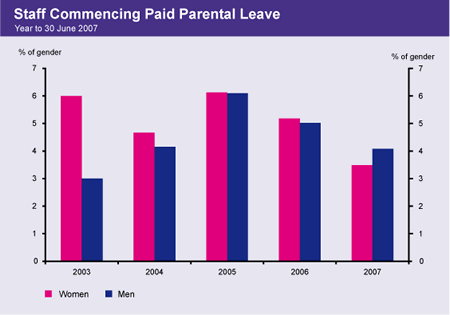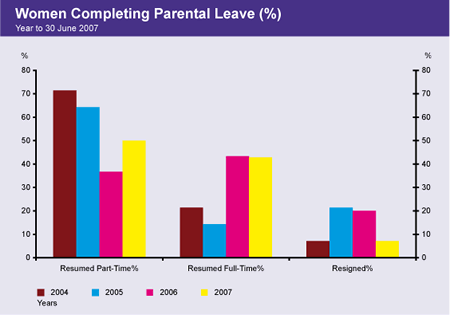Equity & Diversity Annual Report – 2007 Section 4: Work/Life Balance
Section 4.1: Flexible Working Arrangements
The Bank's Workplace Diversity Plan has the objective of ensuring that work/life balance practices and policies are fair and equitable and assist in the retention of valued staff. A number of policies that provide scope for staff to better balance work and family were reviewed over the year.
During the year, the Bank concluded an investigation of options for additional leave flexibility for staff through a purchased leave (48/52) scheme or annual leave on half pay. While deciding that existing arrangements provided adequate flexibility for staff the Bank decided to undertake a comprehensive review of its flexible work options and possible improvements during the next reporting period.
Work also continued on developing flexible working arrangements that would accommodate both the special needs of staff and the operational needs of the Bank in a contingency situation such as a flu pandemic. Improvements were made to remote access to the Bank's computer systems and a policy developed to encourage identified essential staff to install broadband internet connections at home.
The Bank considered a proposal for volunteering leave prepared by a number of staff that involved the Bank providing one day's leave per year for staff to work for a charity or community-based organisation. After considering the proposal, the Bank agreed to implement a volunteering program during the second half of 2007 under which staff could donate a day of paid or unpaid leave and the Bank would in turn make an equivalent financial donation to the staff member's selected charity.

Personal Leave
Personal leave arrangements were reviewed during this reporting period. The proposed new Enterprise Agreement includes an amendment to Personal Leave which allows an increased amount of accrued Personal Leave which may be taken each year for caring purposes. An additional two days unpaid carer's leave once the paid leave entitlement has been exhausted will also be available. Personal Leave for caring purposes can still be taken either on a half or full day basis.
In 2006/07, carer's leave was used by 393 staff (44 per cent), a decrease of two per cent from last year. Of all staff who took the leave, 54 per cent were men, the same as last year. However, 48 per cent of all women used Personal Leave for caring purposes compared with 41 per cent of all men.
The new Enterprise Agreement also incorporates the Australian Fair Pay and Conditions Standard as it applies to Compassionate Leave. Staff will be permitted two days paid compassionate leave per occasion when a member of an employee's immediate family is seriously ill/injured.
Part-Time Work
During the reporting period, existing part-time arrangements were reviewed and streamlined in order to enhance flexibility, encourage the establishment of more part-time work opportunities, and enable staff to better understand the options and conditions applicable to part-time work. The modified arrangements are also to make it easier for managers to implement and manage part-time work for their staff. Statistics will be monitored during the next reporting period to analyse and assess the impact of this amended policy.
During the year, 60 staff worked part-time (55 women, five men) compared with 61 (55 women, six men) in 2006.
Parental Leave
New parental leave provisions were introduced this reporting period covering maternity leave on half pay. Women commencing paid maternity leave now have an option of 28 weeks on half pay as an alternative to the existing entitlement of 14 weeks on full pay. Men are entitled to two week's paid paternity leave but this is not available as a half-pay option at this stage.
The chart below provides a breakdown based on gender for staff commencing paid parental leave. During the reporting period, a total of 34 staff commenced paid parental leave (13 women and 21 men). Analysis reveals an emerging trend of an equal or higher percentage of men taking paid parental leave compared to women. This could be a contributing factor behind the higher utilisation of the Bank's childcare centre by men.

For this reporting period, a total of 14 women returned from parental leave. Seven of those returning resumed part-time, 6 resumed full-time work and one resigned. A 93 per cent return rate was experienced this year compared to 80 per cent last year. The percentage of women resigning prior to completing parental leave for this reporting period was 7 per cent (one woman), 13 per cent lower than for 2005/06 (six women).

Section 4.2: Facilities & Services
Childcare Facilities
The Bank offers salary sacrifice childcare arrangements through its joint venture operation, Billabond Children's Centre, for children aged five years and under. As at end June, 10 Bank parents (two women and eight men) were utilising the Centre with 12 children in attendance. During the reporting period, an investigation commenced into the practicalities of providing Vacation Care programs for children aged 5-12 years. A survey was carried out to assess the demand and the feasibility of vacation care payments to be made via salary sacrifice.

To complement the childcare centre, a well-equipped Parent Room is available for use by staff within the Bank. The room provides a private facility for women returning to work who would like to maintain breastfeeding. Staff on parental leave visiting the Bank that need a private space to breastfeed or change a nappy may also use the room. The room has been accredited by the Australian Breastfeeding Association.
Health & Wellbeing Services
The Bank is committed to ensuring the health, safety and welfare of its staff. The Bank's Health Centre, managed by a qualified Occupational Health Nurse, provides primary health care, ergonomic workstation assessment for all new employees and people experiencing difficulties, counselling and support services for staff and managers/supervisors, and rehabilitation case management for both work-related and non-work-related conditions.
The Bank encourages a healthy lifestyle and as part of its health and wellbeing program offers subsidised Pilates and Yoga classes to Bank staff. In addition, the Bank operates a fitness facility for staff at Head Office.

During the reporting period, a series of lunchtime health and wellbeing sessions were introduced and these will continue to be held throughout the year on a regular basis. The interactive sessions covered a number of topics including nutrition, stress, diabetes, mental health and maintaining energy levels.
Assistive Technologies
Assistive technology is a general term for specialised hardware and software designed for use by people with disabilities who are normally unable to use standard PCs either permanently or for a period of time. The Bank's System Accessibility Technical Group (SATG) set up a facility to test a wider range of assistive technologies that can help staff with a permanent or temporary disability. During the reporting period, the Bank conducted a survey to find out whether staff would benefit from using, any assistive software, electro-mechanical, electronic, computer or other device to assist them in their work. The responses received from this survey were used to help select the technologies installed on the test facility, which will then be used to test new systems and hardware for compatibility.
The Bank continues to investigate satisfactory solutions for conference/meeting rooms to accommodate people with hearing impairments.
Employee Assistance Program
In 2007, the Bank introduced an Employee Assistance Program (EAP) for staff. The aim of the scheme is to assist staff to resolve personal problems at an early stage and avoid situations which might otherwise ultimately affect their work performance or attendance. The EAP covers a wide variety of problems and concerns such as balancing family and work responsibilities, career and vocational issues, managing and coping with change, and dealing with difficult situations. Access to the EAP is available to all staff within Australia and overseas with initial contact via telephone and, if necessary, subsequent face-to-face sessions.
The Bank also continues to offer the Manager Assist program which provides specialist support and advice to managers and supervisors to assist them in responding to people management situations that may be difficult, complex or unusual.